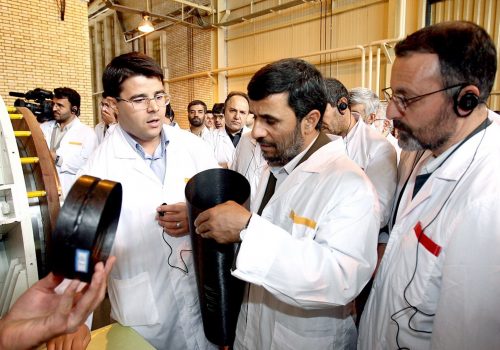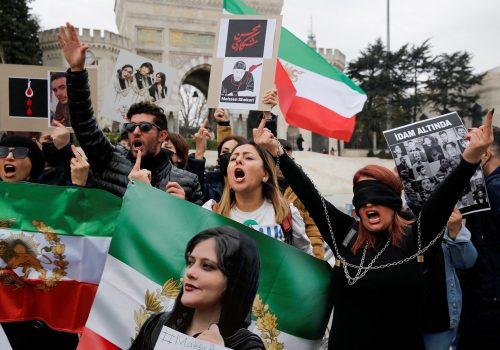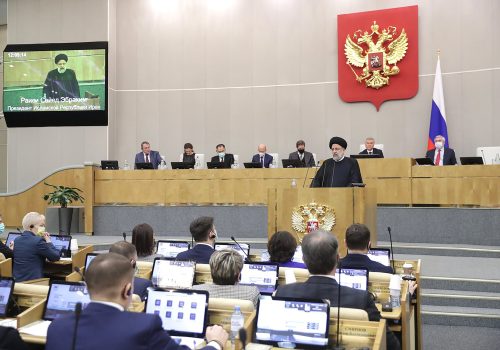This is how Iranian history shapes the Islamic Republic’s relationship with the world
Tensions in the Iran-Russia relationship have surfaced publicly since July, when Russia supported the United Arab Emirates’ (UAE) in its dispute with Iran over islands in the Persian Gulf. Iranian officials publicly criticized Russian behavior and, on July 18, Foreign Minister Hossein Amir-Abdollahian asserted, “The people should not at all think that the Islamic Republic of Iran, with its greatness and power, wants to sell the country to Russia, China, the US, France, Britain, and Germany. Regarding China and Russia, we act within the framework of our interests. But we will never allow our independence, sovereignty, and territorial integrity to be harmed by them.”
While differing national interests contribute to these tensions, history also plays a role in Iran’s relationship with Russia, as well as the rest of the world. Iranians have a long historical memory, and Iran’s foreign policy is shaped in many ways by the nation’s history. It is important for US policymakers to understand how Iran sees the world through the lens of history and use this knowledge to advance US policy goals.
More than recent history—the 1979 revolution and the regime’s four decades of grievances against the United States—drives Iran’s worldview. Despite the Islamic Republic’s attempts to distance itself from the country’s pre-Islamic past and Pahlavi Iran, older historical impulses and experiences still drive Iran’s behavior, whether the regime acknowledges it or not. Three of these impulses are particularly important for US policy and the Iran-Russia relationship: Iran always fiercely resisted foreign domination; Iran often sought a benevolent ally from outside the region to support its quest for sovereignty; and Iran wished to be seen as a serious power deserving of respect.
First, Iran has never wanted to be a client state or dominated by foreign powers. Iranians have a long history of fighting for national sovereignty. As the once-powerful Iran, known then as Persia, grew weaker in the nineteenth century during the Qajar dynasty, it faced increasing pressure from Imperial Russia and Great Britain. Russia repeatedly seized Iranian territory. The 1828 Treaty of Turkmenchay—in which Iran was forced to cede to Russia what is now Armenia, the country of Azerbaijan, and part of Turkey—remains a particularly sore memory. Qajar Iran also became deeply indebted to Russian and British banks, and the two imperial powers forced intensely unpopular concessions that allowed them to dominate Iranian oil, tobacco, and other industries.
The 1907 Anglo-Russian Convention, which the two powers negotiated without consulting Iranians, divided Iran into spheres of influence. Such imperial meddling was one of the leading causes of Iran’s first revolution: the Constitutional Revolution of 1905-1911. Yet Iranians’ efforts to ensure true national sovereignty failed. Russian military intervention in 1911 ended the revolution.
Despite this defeat, Iranian resistance to foreign interference continued. Confronted with the Anglo-Soviet occupation during World War II that forced Reza Pahlavi’s abdication in 1941, Iran insisted upon an international agreement on Allied troop withdrawal. When the Soviet Union refused to withdraw from northern Iran and encouraged communist separatist movements in those provinces in 1946, the Iranian government successfully negotiated and leveraged international pressure to force a Soviet withdrawal. It then crushed the separatists and suppressed the communist Tudeh party as an agent of foreign influence.
In 1951, Iran nationalized its oil industry, a clear renunciation of ongoing British domination of Iranian oil. The resulting CIA- and MI6-backed coup d’etat succeeded in overthrowing Prime Minister Mohammad Mosaddegh, but the event enhanced Iranians’ resolve to resist foreign domination. Mosaddegh became a national hero and the coup laid the groundwork for popular anti-Westernism that grew through the 1970s. Mohammad Reza Pahlavi himself, who had been popular, partly lost legitimacy because of his role in the coup.
Ayatollah Khomeini later built his popular base by decrying Western influence and leading protests against the Shah in 1963; one issue was special legal protections granted to Americans in Iran. Even though many Iranians saw the Shah as a Western puppet after 1953, historians such as Roham Alvandi have demonstrated that the Shah also cherished Iranian sovereignty. He spent decades working to turn Iran into a true partner—not a client—of the United States.
The Islamic Republic continues this profoundly ingrained and historically conditioned struggle for Iranian independence. It views the West as irredeemably imperialistic. The long history of Western hegemony in Iran—and Iranians’ fierce resistance—explains a lot of the regime’s defiance of the West, even in the face of harsh sanctions. Its fears of counter-revolution plotted by an outside power may be paranoid—especially its insistence that the West is to blame for the massive anti-establishment protests that have rocked Iran since September 2022—but also appear reasonable to the regime given Iran’s historical experience of repeated foreign interventions.
When understood in this context, Amir-Abdollahian’s July 18 statement about Russia has deeper resonance. If President Vladimir Putin has indeed resurrected Russia’s imperial ambitions (as many pundits believe), Iran would appear to him as an important area to control and one that has historically been a Russian sphere of influence. While the Islamic Republic and Russia share interests, especially their mutual opposition to the US-dominated world order, Iran must still be wary of Russia’s intentions. Just as the Islamic Republic believes that history serves as a warning not to trust the United States, history also requires Iran to proceed with caution regarding Russia.
Second, in its quest for national sovereignty, Iran historically sought the help of a benevolent ally to shield it from Russian and British imperialism. Iran hoped the United States would play that role in the late nineteenth and early twentieth centuries. It, thus, invited US involvement in Iranian affairs multiple times from the mid-nineteenth century forward. The Americans’ declarations of friendship but reluctance to accept these invitations only made the United States more attractive. Iran also grew closer to Germany in the years before World War II for the same reason. When the war finally drew the United States meaningfully into Iranian affairs, its loud protestations against the Soviets during the 1946 crisis seemed to indicate that the United States was indeed Iran’s friend.
While the 1953 coup ultimately demonstrated that Iranians’ hopes for the United States were misplaced, the Islamic Republic of today is perhaps looking at China in the same light—a potential third force to balance Western pressure and Putin’s Russia. Just as the Middle East was not a traditional area of American influence before World War II, so too is the region not a traditional area of Chinese influence today.
China does not carry the historical baggage of Europe or Russia in Iranian eyes, and it has useful economic and diplomatic power. Unlike the West, China is also willing to overlook Iran’s human rights abuses against its people. However, China may be as disinterested in deep involvement in Iranian affairs as the United States was in earlier periods. China wants access to Iranian oil and has used its diplomatic influence in the Middle East for international prestige and self-interest. Yet China may end up declining to provide the robust support the Islamic Republic desires.
Third, modern Iran has always seen itself as the home of once-great empires and as a major regional power that should be treated as an equal by other world powers. This was a major motivating factor for the Shah’s foreign policy. His modernization programs, military build-up, and grand 1971 celebration in Persepolis were all intended to showcase Iran’s greatness. The Shah’s assertiveness with American policymakers by the 1970s indicated that he saw his country as an equal to the West.
The Islamic Republic is also motivated by this belief. It sees its theocracy as superior to other government models and wants the world to recognize Iran’s importance. Iran is increasingly confident in its foreign behavior because it sees itself as a serious global player. Its policies in the Middle East—meddling in the affairs of its neighbors to advance its interests, acting through proxies, intervening in Yemen’s and Syria’s civil wars, and improving its military technology and nuclear ambitions—are the policies of a regional or even aspiring global power. Other powers have acted similarly, including the United States and Russia.
Iran’s increasing use of cyberattacks, too, is a declaration of its power; this is the terrain of twenty-first-century great power competition. The Islamic Republic’s naval buildup and overtures to Latin America, including its unsuccessful 2021 naval venture in the Atlantic, indicate its aspirations.
Such a worldview also explains how Iran has tried to position itself as a partner—not a client—of Russia. Iran signaled its status as Russia’s equal by sending drones to help its ally in the war in Ukraine. Iran was the country providing military aid—not the one being aided. Furthermore, client states produce raw materials, not highly advanced military technology. The Islamic Republic also knows that the international community rarely punishes great powers for human rights violations; external strength allows it a free hand at home.
History thus shapes the Islamic Republic’s engagement with the world. And, yet, while it shares the same historical experiences with the Iranian people, their interpretation of this history differs from the regime’s. The Iranian people do share in the longer historical opposition to foreign domination. Still, many also resist the Islamic Republic’s use of history as a tool of domestic control and its characterization of the West as Iran’s enemy.
Iranians take pride in Iran’s pre-Islamic past, which the regime seeks to downplay. They seek to resurrect the histories of Iran’s women’s rights and democracy movements, dating back to the Constitutional Revolution. They also actively remember individual Americans who were Iran’s friends—from Howard Baskerville, who died fighting alongside Iranian constitutionalists in 1909, to the almost 1,800 Peace Corps volunteers who served in Iran. Unlike their government, many Iranians once again see the United States as a potential ally and hope it will be a friend to their current revolutionary movement. Consequently, Iran’s history can be both an obstacle and opportunity for US policy.
American policymakers should therefore use history wisely. The United States should encourage the Iranian people’s version of history. It should especially demonstrate that Iranians’ historical hopes for the United States are not misplaced by meaningfully supporting the current revolutionary movement, assisting with capacity building for democracy, and speaking out on behalf of Iranians’ human rights. In doing so, however, the US must be careful to allow the Iranian people to take the lead; Iranian history emphasizes that a foreign power must not install any post-Islamic Republic government for it to have domestic legitimacy.
The United States must also exploit Russia’s problematic history in Iran. By highlighting potential Russian designs on Iran, making it seem like Putin doesn’t see Iran as an equal, and emphasizing that Russia wants to dominate Iran like Imperial Russia sought to do in 1907, US propaganda may help enhance the already existing tensions between the Islamic Republic and Russia.
Finally, US policymakers should take Iran seriously as a regional power. The United States must respect Iran as a formidable adversary and devote resources to developing a long-term Iran policy that is consistent and proactive. Iran can no longer be seen as less important to American interests than other countries. Its ongoing domestic instability and vulnerability to its history should receive equal attention to other policy issues, such as Ukraine.
The Islamic Republic’s inability to provide what its people want—basic necessities and human rights—and its increasing confidence in its external behavior will be challenging to navigate. Nevertheless, remembering Iran’s deep desire for respect and influence on the one hand, and its historical experience with and hostility to foreign coercion or control on the other, is important when formulating policy. For both the Islamic Republic and the Iranian people, history matters. It should matter to US policymakers as well. The question is, whose historical memory will win out: the mullahs’ or the people’s? And which side of history will the US find itself on this time?
Kelly J. Shannon is associate professor of history at Florida Atlantic University and a 2023-2024 W. Glenn Campbell and Rita Ricardo-Campbell National Fellow at the Hoover Institution. She is the author of US Foreign Policy and Muslim Women’s Human Rights and is currently writing a book on US-Iran relations in the first half of the twentieth century.
Further reading
Tue, Dec 8, 2020
A history of continuity in Iran’s long nuclear program
IranSource By Sina Azodi
Iran’s interest in developing a nuclear deterrent is often attributed to the Islamic Republic. However, in reality, this interest predates the 1979 revolution and reflects a deep-seated desire for national prestige and development, as well as a need to deter regional rivals.
Thu, Dec 22, 2022
I’m a former Syrian civil society activist. Syrians can’t tell Iranians how to win, but we can share lessons we learned the hard way.
IranSource By
Be the Iran you want to see.
Mon, Mar 7, 2022
As the world shuns Russia over its invasion of Ukraine, Iran strengthens its ties with Moscow
IranSource By
Iran’s support for Russian actions reflects the improvement in bilateral ties, which have grown considerably at the political and military levels over the past decade.
Image: Iranian Foreign Minister Hossein Amir-Abdollahian meets with Russia's Foreign Minister Sergei Lavrov in Cape Town, South Africa, June 2, 2023. Iran's Foreign Ministry/WANA (West Asia News Agency)/Handout via REUTERS


